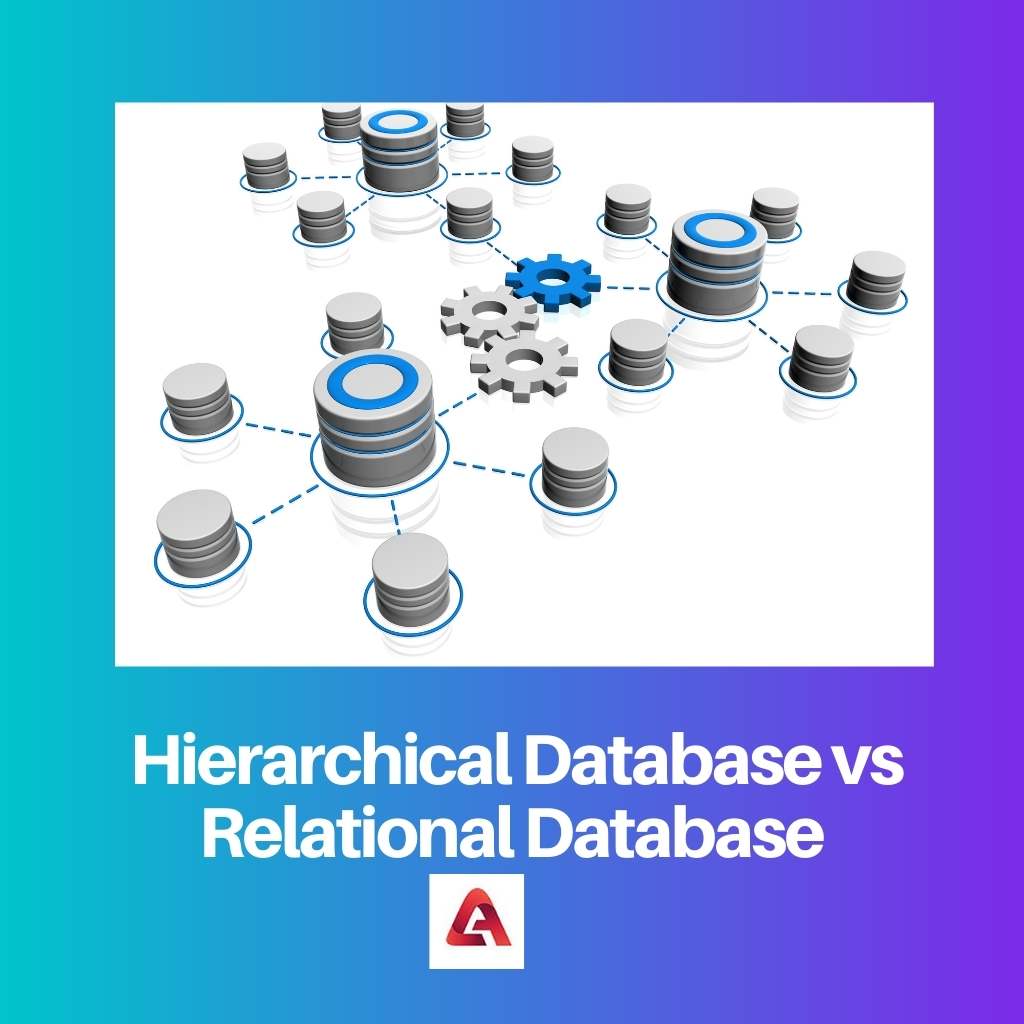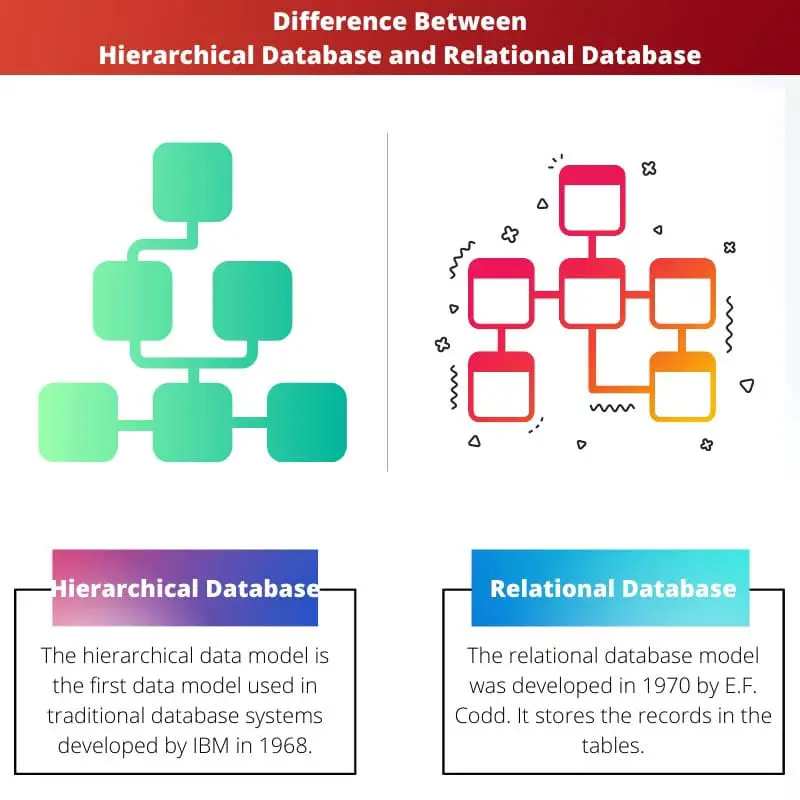Data is most important for business organizations as they store and process it in database management systems. A database management system helps users to view their data as they want by hiding the storage details.
Database models are used to abstract the data to the users. Hierarchical and relational database models are most commonly used in building databases.
Key Takeaways
- Hierarchical databases use a tree-like structure, organizing data in parent-child relationships.
- Relational databases store data in tables with rows and columns linked by keys.
- Relational databases provide greater flexibility and ease of querying compared to hierarchical databases.
Hierarchical Database vs Relational Database
A hierarchical database stores data in a tree-like structure with one parent record connected to multiple child records and is suited for storing and accessing data with a fixed structure. A relational database stores data in tables that common attributes or keys can link.

A hierarchical database is the first-generation database system used in applications to store and retrieve data. It is used in IBM mainframes even today.
It is a simple database structure but not suitable for storing complex and large data sets. Retrieval of data from this table is time-consuming.
On the other hand, relational database models are second-generation database systems that overcome the disadvantages of hierarchical databases by storing the data in tables, and views, and connecting the databases with relationships.
It ensures that data is redundant in the tables, which makes it easy to retrieve, modify, and update.
Comparison Table
| Parameters Of Comparison | Hierarchical Database | Relational Database |
| Developed by | IBM in 1968 | E.F. Codd in 1970 |
| Generation | It is a First generation data model. | It is a Second generation data model. |
| Structure | A Tree structure that has parent nodes and child nodes | The Tabular form with rows and columns |
| Relationships | One-one,one-many | One-one,one-many,many-many |
| Data retrieval | The tree must be traversed from the root node to the required node | Using SQL query language. |
What is Hierarchical Database?
The hierarchical data model is the first data model used in traditional database systems developed by IBM in 1968. It is a model where the data is stored in a parent-child model where the child has only one parent.
It forms a tree-like structure where child nodes are the records that are connected via links. The first node in the tree is called the root node, which has no parent node.
The parent node can have multiple child nodes, but a child must be connected to only the parent node. Hence the database model satisfies one-one and one-many relationships.
The biggest advantage of a hierarchical database is that data access is easy and predictable. The retrieve and update are easily optimizable.
The biggest disadvantage of the database is that links cannot be modified as they are hard coded. If there is any requirement for modification to the database, then the whole database must be redesigned.
The hierarchical databases are simple but flexible. It stores redundant data, which increases the complexity of retrieving the data.
As the hierarchical database has to be coded in the application, any change in the database requires the developer to change the code of the application.
Hierarchical databases are still used in the IBM mainframes but are not preferred for modern applications.
What is Relational Database?
The relational database model was developed in 1970 by E.F. Codd. It stores the records in the tables. The tables consist of rows and columns where the row denotes entities, and the column denotes attributes of the records.
Tables are linked with relations only when they share common attributes. Relational databases are user-friendly, programming friendly, and are preferred in industries over hierarchical databases.
Some of the relational database management systems are Oracle, DB2, MS-SQL Server, and Informix.
A relational database is not dependent on applications, and any changes in the database will not affect the application programming. This database is also suitable for defining complex relationships among tables easily.
In relational database systems, the logical structure is stored separately from the physical structure of the data. This helps to manage the structures differently without affecting each other.
Relational databases follow integrity rules to eliminate duplicate data in the tables. The SQL query language is used to retrieve the data from the database with consistency and accuracy.
Relational databases ensure ease of access to required databases by maintaining consistency. It is also easy to back up, import, and export data easily at the time of emergency. Relational databases comply with an ACID property also.
Main Differences Between Hierarchical Database and Relational Database
- The hierarchical database must be coded within the application, whereas relational databases are independent of the application.
- Hierarchical database stores data in the form of parent and child nodes forming a tree structure, whereas a relational database stores data in the rows and columns of a table.
- A hierarchical database implements only one-one and one-to-many relationships, whereas a relational database also implements many-to-many relationships.
- The whole tree has to be traversed to retrieve data in a hierarchical database, and SQL query language is used in relational databases to retrieve data.
- The hierarchical Database is the first-generation database system, and the relational database is the second-generation database.

The article illustrates the advantages and disadvantages of both hierarchical and relational databases, providing a comprehensive understanding of their differences.
The comparison table offers a clear overview of the features and characteristics of each database model, aiding in the understanding of their functionalities.
The article provides a thorough explanation of hierarchical and relational databases, helping to enhance knowledge in database management.
Informative comment on the different database management systems and their usefulness in business organizations.
It’s intriguing to see the contrast between hierarchical and relational databases, shedding light on their distinct data storage approaches.
It’s interesting to note the historical development of these database systems and how they are utilized in modern applications.
The database comparisons are insightful and offer a valuable insight into the intricacies of data management systems.
It is fascinating to learn about the comparison between hierarchical and relational databases and how they store and manage data differently.